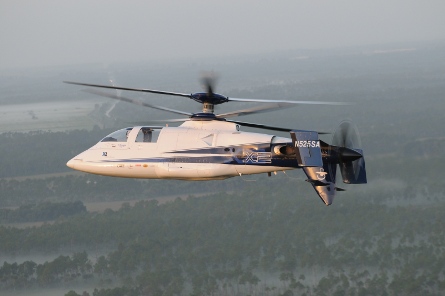Sikorsky today unofficially broke the helicopter speed record as the X2 technology demonstrator reached 225kt (417km/h) during a 1h flight test.
The compound, coaxial rotor system surpassed by 9kt the official record set by the Westland Lynx in 1986, Sikorsky X2 chief engineer Steve Weiner says.
The Lynx's 216kt record, however, stands in the Federation Aeronautique International (FAI)'s books until Sikorsky conducts the flight with an official observer present from the National Aeronautic Association, he adds.
Although the X2 is now unofficially the world's fastest helicopter, Sikorsky's goal is to raise the speed limit by at least 25kt within two months.
 |
|---|
©Sikorsky |
X2 chief pilot Kevin Bredenbeck says the aircraft "still has a lot of power" at 225kt, prompting Sikorsky officials to consider the possibility of pushing the aircraft slightly beyond the 250kt-goal for the test programme.
Another positive sign is that recent changes to the flight control system and increased tail surface area has improved the aircraft's stability.
"My workload is down and now I'm just along for the ride," Bredenbeck says.
Sikorsky has quickly added two horizontal surfaces with a total area of 0.46m² (5ft²) to the X2's inverted tail to counteract instability in pitch, Weiner says.
The ideal solution for the longitudinal stability issue would involve enlarging the main horizontal tail, but that would have required a more significant redesign, says Sikorsky programme manager for advanced programmes Jim Kagdis.
The X2 is now entering the final two months of a nearly-year-long pursuit of the 250kt-speed goal. Sikorsky will add a new aerodynamic tail surface, as planned, to reduce drag.
Sikorsky launched the X2 demonstrator in hopes of delivering a dramatic increase in speed for the next generation of military and civil helicopters. The aircraft reuses the T800 engine from the cancelled RAH-66 Comanche programme. But the programme's legacy is mostly based on the Sikorsky XH-59 advancing blade concept (ABC) programme from nearly 40 years ago.
The XH-59 also employed a compound, coaxial rotor power system to boost speed, but failed to overcome vibration and stability control problems in an era before the invention of fly-by-wire technology for helicopters.
Sikorsky timed the X2's record-setting flight to coincide with the 37th anniversary of the first flight of the XH-59, Bredenbeck says.
No members of the original XH-59 staff were on hand to witness the milestone flight, but former Sikorsky chief test pilot John Dixson was asked to observe as a consultant. After completing the historic flight today, Bredenbeck recalled hearing few praises from Dixson while he ran Sikorsky's flight test team.
But Dixson told Sikorsky's staff today that "they should be proud for what they have accomplished" during the X2 programme, Bredenbeck says.
Source: Flight International













